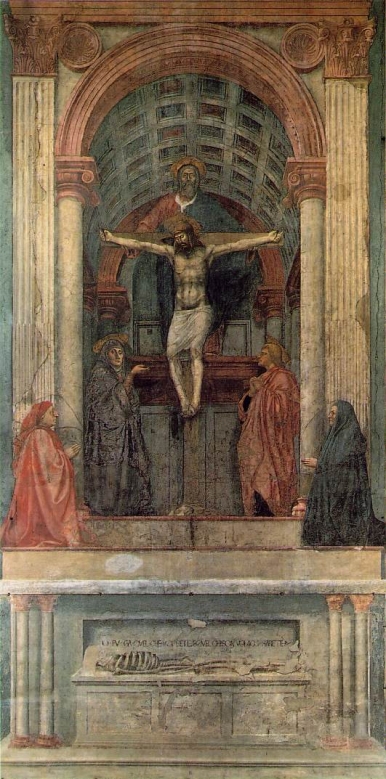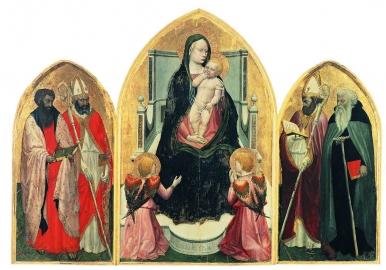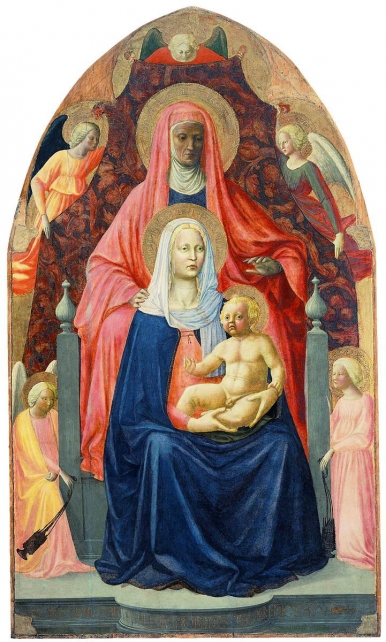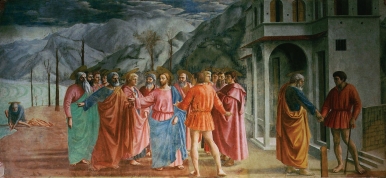마사초(Masaccio)FOLLOW
1401년12월21일 이탈리아 San Giovanni Valdarno 출생 - 1428년
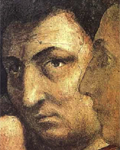
추가정보
마사치오는 한 세기 전 인간적이고 사실적인 묘사를 시도했던 조토를 계승하여 진정한 의미의 르네상스 회화를 시작한 화가이다.
의문의 죽음으로 28세의 짧은 생애를 보낸 이 천재 화가는 15세기 이탈리아 회화의 혁신가라고 할 수 있다.
마사치오는 르네상스 대표적인 조각가인 브루넬레스키가 이루어낸 수학적 원근법을 최초로 회화에 도입했으며, 또한 최초로 인체에 그림자를 그려내었다. 그는 원근법과 명암법을 통해 화면에 깊이감와 입체감을 부여했고, 이는 인물들이 마치 살아있는 듯한 표현력과 실체적인 느낌을 더해 주었다.
Masaccio (born Tommaso Casser or in some accounts Tommaso di Ser Giovanni di Mone; December 21, 1401 – autumn 1428), was the first great painter of the Quattrocento period of the Italian Renaissance. His frescoes are the earliest monuments of Humanism, and introduce a plasticity previously unseen in figure painting.
The name Masaccio is a humorous version of Tommaso, meaning "big", "fat", "clumsy" or "messy" Tom. The name was created to distinguish him from his principal collaborator, also called Tommaso, who came to be known as Masolino ("little/delicate Tom").
Despite his brief career, he had a profound influence on other artists. He was one of the first to use scientific perspective in his painting, employing techniques such as vanishing point in art for the first time. He also moved away from the Gothic style and elaborate ornamentation of artists like Gentile da Fabriano to a more natural mode that employed perspective for greater realism.
Early life
Masaccio was born to Giovanni di Mone Cassaài and Jacopa di Martinozzo in Castel San Giovanni di Altura, now San Giovanni Valdarno (now part of the province of Arezzo, Tuscany). His father was a notary and his mother the daughter of an innkeeper of Barberino di Mugello, a town a few miles south of Florence. His family name, Cassai, comes from the trade of his grandfather Simone and granduncle Lorenzo, who were carpenters - cabinet makers ("casse", hence "cassai"). His father died in 1406, when Tommaso was only five; in that year another brother was born, called Giovanni after the dead father. He also was to become a painter, with the nickname of "Scheggia" meaning "splinter". The mother was remarried to an elderly apothecary, Tedesco, who guaranteed Masaccio and his family a comfortable childhood.
The family probably moved to Florence at the death of Tedesco, in August 1417. Little is known about this period until Tommaso joined one of the seven main crafts guilds in Florence, on January 7, 1422, signing as "Masus S. Johannis Simonis pictor populi S. Nicholae de Florentia". In the new city Tommaso received his nickname, meaning "Clumsy Thomas" for the little care he gave to worldly affairs and to personal appearance: otherwise he was considered a good-natured person.
First works
The first works attributed to Masaccio are the Cascia Altarpiece, (1422), picturing the Madonna enthroned with angels and saints, and a Virgin and Child with St. Anne, (ca. 1424) at the Uffizi: they were already works of very high quality. The second work was a collaboration with an older and already renowned artist, Masolino da Panicale, and for many years it was assumed Masaccio was simply an apprentice to Masolino. More recently it has been noted that Masaccio gained entry to the Painters' Guild before Masolino, suggesting that their collaboration was for convenience or simply moved by mutual esteem. Masaccio's talent was apparent, and was probably already superior to that of Masolino. The source of the younger master's education remains an enigma; it is still not known where Masaccio received his training in art.
Maturity
In Florence, Masaccio could study the works of Giotto and become friends with Alberti, Brunelleschi and Donatello. According to Vasari, at their prompting in 1423 Masaccio travelled to Rome with Masolino: from that point he was freed of all Gothic and Byzantine influence, as may be seen in his altarpiece for the Carmelite Church in Pisa, the central panel of which (The Madonna and the Child) is now in the National Gallery, London. As well as a sculptural and human Madonna the work features a convincing perspectival depiction of her throne. The traces of influences from ancient Roman and Greek art that are present in some of Masaccio's works presumably originated from this trip: they should also have been present in a lost Sagra, (today known through some drawings, including one by Michelangelo), a fresco commissioned for the consecration ceremony of the church of Santa Maria del Carmine in Florence (April 19, 1422). It was destroyed when the church's cloister was rebuilt at the end of the 16th century.
The Tribute Money, fresco in the Brancacci Chapel in Santa Maria del Carmine, Florence[edit] Brancacci chapel
In 1424 the "duo preciso e noto" ("well and known duo") of Masaccio and Masolino was commissioned by the powerful and rich Felice Brancacci to execute a cycle of frescoes for the Brancacci Chapel in the church of Santa Maria del Carmine in Florence. The theme of the frescoes in the little chapel was to be the "Histories of St. Peter". The genius of Masaccio shows clearly in these frescoes. In the "Resurrection of the Son of Theophilus", he painted a pavement in perspective, framed by large buildings to obtain a depth of field and three-dimensional space in which the figures are placed proportionate to their surroundings. In this he was a pioneer in applying the newly discovered rules of perspective.
When it was cleaned, Tommaso Masaccio's fresco of The Expulsion (1426–1427) lost the added fig leaves.Masaccio's scenes show his reference to Giotto especially. The Expulsion from the Garden of Eden, depicting a distressed Adam and Eve nude, had a huge influence on Michelangelo. Another major work is The Tribute Money in which Jesus and the Apostles are depicted as neo-classical archetypes. Seldom noted is that the shadows of the figures all fall away from the chapel window, as if the figures are lit by it; this an added stroke of verisimilitude and further tribute to Masaccio's innovative genius.
On September 1425 Masolino left the work and went to Hungary. It is not known if this was because of money quarrels with Felice or even if there was an artistic divergence with Masaccio. It has also been supposed that Masolino planned this trip from the very beginning, and needed a close collaborator who could continue the work after his departure.
Some of the scenes completed by the duo were lost in a fire in 1771; we know about them only through Vasari's biography. The surviving parts were extensively blackened by smoke, and the recent removal of marble slabs covering two areas of the paintings has revealed the original appearance of the work. Masaccio left the frescoes unfinished in 1426 in order to respond to other commissions, probably coming from the same patron. However, it has also been suggested that the declining finances of Felice Brancacci were insufficient to pay for any more work, so the painter therefore sought work elsewhere.
Resurrection of the Son of TheophilusMasaccio returned in 1427 to work again in the Carmine, beginning the Resurrection of the Son of Theophilus, but apparently left it, too, unfinished, though it has also been suggested that the painting was severely damaged later in the century because it contained portraits of the Brancacci family, at that time excoriated as enemies of the Medici. This painting was either restored or completed more than fifty years later by Filippino Lippi.
Other works
On February 19, 1426 Masaccio was commissioned by Giuliano di Colino degli Scarsi, for the sum of 80 florins, to paint a major altarpiece, the Pisa Polyptych, for his chapel in the church of Santa Maria del Carmine in Pisa. The work was dismantled and dispersed in the 18th century, and only eleven of about twenty original panels have been rediscovered in various places in the world. Masaccio probably worked on it entirely in Pisa, shuttling back and forth to Florence, where he was still working on the Histories of St. Peter. In these years Donatello was also working in Pisa at a monument for Cardinal Rinaldo Brancacci, to be sent to Naples. It has been suggested that Masaccio's first ventures in plasticity and perspective were based on Donatello's sculpture, before he could study Brunelleschi's more scientific approach to perspective.
Fresco in the Brancacci Chapel in Santa Maria del Carmine, FlorenceThrough the help of Brunelleschi, in 1427 Masaccio won a prestigious commission to produce a Holy Trinity for the Santa Maria Novella church in Florence. The fresco, considered by many his masterwork, marks the first use of systematic linear perspective, possibly devised by Masaccio with the assistance of Brunelleschi himself.
Masaccio produced two other works, a Nativity and an Annunciation, now lost, before leaving for Rome, where his companion Masolino was frescoing the Basilica di San Clemente. It has never been confirmed that Masaccio collaborated on that work, even though it is possible that he contributed to Masolino's polyptych of the altar of St. Mary Major with his panel portraying St. Jerome and St. John the Baptist, now in the National Gallery of London. Masaccio died at the end of 1428. According to a legend, he was poisoned by a jealous rival painter.
Only four frescoes undoubtedly from Masaccio's hand still exist today, although many other works have been at least partially attributed to him. Others are believed to have been destroyed.

